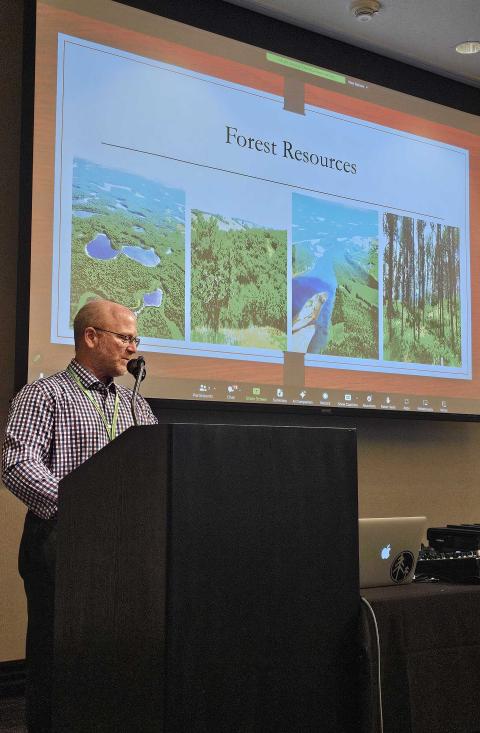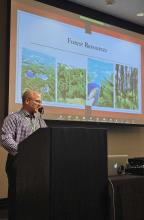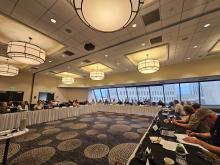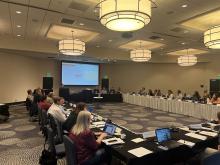The Council of Western State Foresters (CWSF) and Western Forestry Leadership Coalition (WFLC) convened May 21-23 for the 2024 Spring Meeting.
This meeting brought together over 80 attendees from across the West to discuss topics such as Infrastructure Investment and Jobs Act (IIJA) and Inflation Reduction Act (IRA) funding, State Forest Action Plans, National Forest System planning, the housing crisis, and impacts on the local workforce, and fuels reporting processes and metrics.
Attendees included representatives from 16 western state forestry agencies, seven regions of the USDA Forest Service (Forest Service), and several partner organizations.
The meeting kicked off with a keynote address by Andria Weeks, Forest Service Associate Deputy Chief for State, Private, and Tribal Forestry. Associate Deputy Chief Weeks highlighted recent increased investments thanks to IIJA and IRA, and the great work that has been accomplished in partnership with states and regions.
Following the keynote, Bernhardt Saini-Eidukat from North Dakota State University (NDSU) opened with an overview of the state’s history and land acknowledgment. Saini-Eidukat painted a picture for attendees as they traveled through formative time periods and offered a geological perspective on the formation of the state.
Allyson Burcham and Scott Liudahl of the City of Fargo Forestry Department shared further details about the state and educated participants on the city’s forestry programs, which oversee more than 60,000 trees.

North Dakota State Forester Tom Claeys wrapped up the local North Dakota welcome with an overview of the North Dakota Forest Service’s program and alignment with NDSU. Claeys also presented statistics from the state, highlighting that North Dakota ranks as the 19th largest state yet is the second least forested in the U.S.
CWSF/WFLC Director of Policy Neil Simpson shared updates on the Wildland Fire Mitigation and Management Commission report (Wildfire Commission Report), FY 2025 Appropriations, Community Wildfire Defense Grants, and other items of legislative interest, including recently introduced and potential legislation.
Day one ended with a discussion on how members are engaging with and furthering recommendations from the Wildfire Commission Report, followed by a conversation focused on innovative efforts to tackle housing shortages affecting the forestry workforce.
On day two, the group divided for focused conversations among the CWSF membership, and between Forest Service leaders.
Topics at the CWSF meeting included recent changes to the Forest Service forest planning structure and what this means for the future of forest plan revisions (led by Jenna Sloan), forthcoming deadlines for State Forest Action Plan reviews and reports and IRA cost-share program (led by Alice Ewen), and the Forest Service Community Navigator Program (led by Jonathan Bruno with Coalitions & Collaboratives).
Participants were also briefed by the National Association of State Foresters, the Southern Group of State Foresters, and the Northeast-Midwest State Foresters Association.
A key component of each Spring Meeting involves a closed business session dedicated to conducting CWSF Executive Committee elections and receiving a financial update from the Treasurer's Report.
The newly elected 2024-2025 CWSF Executive Committee includes Chair John Erixson (NE), Incoming Chair Kelly Norris (WY), Treasurer Jamie Barnes (UT), and Immediate Past Chair David Smith (HI). The transition to the 2024-2025 Executive Committee will take place at the end of September.
CWSF/WFLC Executive Director Danielle Okst shared brief highlights on CWSF and WFLC’s work, including the hiring of new staff, forthcoming communications products, and tentative grant timelines.
State Foresters participated in a roundtable discussion to exchange insights and discuss issues affecting their respective states. Themes covered in the roundtable included increased investments through IIJA and IRA, loss of infrastructure with industry, workforce and housing issues, and opportunities for shared storytelling.
On the final day of the 2024 Spring Meeting, participants engaged in an important conversation around fuels reporting processes and metrics to address data interoperability, accomplishments tracking, and shared accountability.
This conversation reaffirmed the importance of cross-boundary work and coordination to provide a comprehensive picture of fuels accomplishments, and helped members identify opportunity areas for process improvement, as well as feedback and learning around ongoing efforts to tell success stories beyond acres treated. WFLC members also expressed a desire to continue this dialogue at future meetings.
Members will reconvene for the 2024 CWSF/WFLC Fall Meeting in Missoula, MT, November 5-7, 2024.
Thank you to 2024 Spring Meeting Sponsors - Nova Maps, Pano AI, and Timmons Group.
--
Click the thumbnails below to view photos from the meeting.





